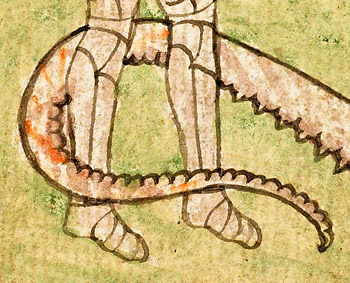Eger and Grime
General Information
Plot Summary

Sir Eger, a poor but undefeated bachelor, loves Winglaine, the proud daughter of his lord; she insists that she will marry only a man who can win every battle he undertakes. Eager to confirm his martial superiority, Eger rides out on adventure. But he soon returns, sorely wounded, to the chamber he shares with his sworn-brother, Sir Grime. Eger recounts his defeat at the hand of Greysteel, a gigantic, red-gold knight who beats him into a swoon and cuts off the little finger of his right hand, and his magical cure by Loosepaine, a mysterious lady physician who provides him with costly dressings, a rejuvenating green potion and two new shirts. Loosepaine’s ministrations are, however, impermanent and when Eger returns home, his body is again as battered as when Greysteel left him.
Grime promises to keep Eger’s defeat a secret but the men’s conversation is overheard by Winglaine who immediately despises her wounded lover. Claiming that Eger was victorious in his adventure but overcome by thieves on the way home, an explanation that satisfies all but Winglaine, Grime plots to avenge his friend’s defeat. Arming himself with a famous sword, Grime leaves his natural brother Pallyas in his place, Eger in bed feigning illness and pretending to be Grime, and sets off, disguised as Eger.
He follows Eger’s directions to Loosepaine’s court where he immediately falls in love with the beautiful lady. Although, she initially mistakes him for Eger, when she removes his glove, Loosepaine discovers five intact fingers and the ruse; her anger is assuaged only when Grime tells her of Eger’s amorous predicament. Loosepaine recounts her own woe at having lost a husband and brother to Graysteel and reveals the secret of his apparently matchless strength (it waxes between midnight and noon and wanes between noon and midnight). Promising to avenge her loss as well as Eger’s defeat, Grime rides off into Graysteel’s lands where he soon encounters the red-gold knight. The two men fight and Grime emerges victorious. He cuts off the dead knight’s hand, in exchange for Eger’s finger, and returns to Loosepaine’s bower where the hand is locked in a coffer and Grime is healed of his wounds. The pair confess their love and are betrothed.
Grime returns home and manages to slip into his chamber undiscovered. He gives his tokens of victory to Eger who presents them, as his own, to the court. There is much rejoicing; Winglaine and Eger are reconciled and marry.
At this point the two surviving versions diverge. In Percy, after forty days of feasting, Eger, Grime and Pallyas return to Loosepaine’s court; Grime marries his beloved and Pallyas marries the daughter of Graysteel. The all live happily and produce many children. In the longer, printed texts (where details are changed, including the characters’ names, and amplified), Grime marries Loosepaine but dies shortly afterwards. In a fit of honesty, Eger confesses the truth to Winglaine who repudiates him. Eger rides off to Rhodes, where for two years he fights heathens; Winglaine dies and Eger returns to marry Loosepaine.
Manuscripts
Click a title below to search for all romances in that manuscript.